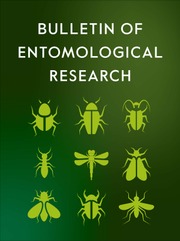No CrossRef data available.
Article contents
Asexual queen succession in the subterranean termite Reticulitermes aculabialis Tsai et Hwang (Blattodea: Heterotermitidae)
Published online by Cambridge University Press: 25 February 2025
Abstract
Asexual queen succession (AQS) species produce queens via thelytokous parthenogenesis, which significantly impacts their social life history. For the first time, we discovered that Reticulitermes aculabialis exhibits the phenomenon of parthenogenesis under experimental conditions, and we also investigated the genetic structure of wild colonies of this species using polymorphic microsatellite loci. Our genetic analysis revealed that 93.2% of the secondary queens in the wild colonies were homozygous at all loci, indicating parthenogenesis in these secondary queens, while workers (2.5%), soldiers (0%), nymphs (0%), and alates (6.7%) had low rates. Genetic analysis revealed that the mean number of alleles per group (Na) ranged from 2.000 ± 0.000 to 2.500 ± 0.428, with 83.3% polymorphic loci (PPL). The observed heterozygosity (Ho) varied from 0.467 ± 0.141 to 0.583 ± 0.098, indicating significant genetic diversity among workers and soldiers. In contrast, soldiers and nymph develop predominantly through sexual reproduction than alates and workers. The occurrence of AQS in R. aculabialis suggests a different mechanism of ploidy restoration, highlighting the diversity of reproductive mechanisms across various lineages of the Termitidae and non-Termitidae termites.
Keywords
- Type
- Research Paper
- Information
- Copyright
- © The Author(s), 2025. Published by Cambridge University Press.



